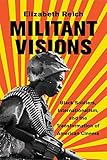Militant Visions : Black Soldiers, Internationalism, and the Transformation of American Cinema / Elizabeth Reich.
Material type: TextPublisher: New Brunswick, NJ : Rutgers University Press, [2016]Copyright date: ©2016Description: 1 online resource (286 p.) : 7 photographsContent type:
TextPublisher: New Brunswick, NJ : Rutgers University Press, [2016]Copyright date: ©2016Description: 1 online resource (286 p.) : 7 photographsContent type: - 9780813572604
- 9780813572604
- 791.43/652996073 23
- PN1995.9.S64 R46 2016eb
- online - DeGruyter
- Issued also in print.
| Item type | Current library | Call number | URL | Status | Notes | Barcode | |
|---|---|---|---|---|---|---|---|
 eBook
eBook
|
Biblioteca "Angelicum" Pont. Univ. S.Tommaso d'Aquino Nuvola online | online - DeGruyter (Browse shelf(Opens below)) | Online access | Not for loan (Accesso limitato) | Accesso per gli utenti autorizzati / Access for authorized users | (dgr)9780813572604 |
Frontmatter -- Contents -- Acknowledgments -- Introduction: Historicizing and Internationalizing the "Baadasssss" or Imagining Cinematic Reparation -- Part I. "We Return Fighting": The Integration of Hollywood and the Reconstruction of Black Representation -- 1. The Black Soldier and His Colonial Other -- 2. Resounding Blackness: Liveness and the Reprisal of Black Performance in Stormy Weather -- 3. Remembering the Men: Black Audience Propaganda and the Reconstruction of the Black Public Sphere -- Part II. "Fugitive Movements": Black Resistance, Exile, and the Rise of Black Independent Cinema -- 4. Psychic Seditions: Black Interiority, Black Death, and the Mise-en- Scène of Resistance in Cold War Cinema -- 5. Toward a Black Transnational Cinema: Melvin Van Peebles and the Soldier -- 6. The Last Black Soldier: Performing Revolution in The Spook Who Sat by the Door -- Conclusion: After Images -- Notes -- Selected Bibliography -- Index -- About the Author
restricted access online access with authorization star
http://purl.org/coar/access_right/c_16ec
Militant Visions examines how, from the 1940s to the 1970s, the cinematic figure of the black soldier helped change the ways American moviegoers saw black men, for the first time presenting African Americans as vital and integrated members of the nation. In the process, Elizabeth Reich reveals how the image of the proud and powerful African American serviceman was crafted by an unexpected alliance of government propagandists, civil rights activists, and black filmmakers. Contextualizing the figure in a genealogy of black radicalism and internationalism, Reich shows the evolving images of black soldiers to be inherently transnational ones, shaped by the displacements of diaspora, Third World revolutionary philosophy, and a legacy of black artistry and performance. Offering a nuanced reading of a figure that was simultaneously conservative and radical, Reich considers how the cinematic black soldier lent a human face to ongoing debates about racial integration, black internationalism, and American militarism. Militant Visions thus not only presents a new history of how American cinema represented race, but also demonstrates how film images helped to make history, shaping the progress of the civil rights movement itself.
Issued also in print.
Mode of access: Internet via World Wide Web.
In English.
Description based on online resource; title from PDF title page (publisher's Web site, viewed 07. Jan 2021)


